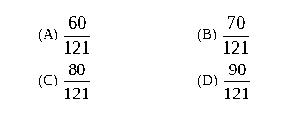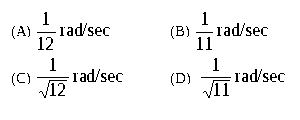| Multiple
Choice Questions Multiple choice
questions in all papers and sections will contain four answers, of which only one is
correct. The types
of questions in a paper may be based on following logic:
(i) Recall:
These are based
on facts, principles, formulae or laws of the discipline. The candidate is
expected to be able to obtain the answer either from his/her memory of the
subject or at most from a one-line computation.
Example
Q. During machining maximum heat is produced
(A) in flank face (B)
in rake face
(C) in shear zone (D) due to friction between chip and tool.
(ii) Comprehension:
These questions will
test the candidate's understanding of the basics of his/her field, by
requiring him/her to draw simple conclusions from fundamental ideas.
Example
Q. A DC motor requires a starter in order
(A) to develop a starting
torque
(B) to compensate for auxiliary field ampere turns
(C) to limit armature current at starting
(D) to provide regenerative braking
(iii) Application: In these
questions, the candidate is expected to apply his/her knowledge either
through computation or by logical reasoning.
Example:
Q. The
sequent depth ratio of a hydraulic jump in a rectangular channel is
16.48. The Froude number at the beginning of the jump is:
(A) 10.0
(B) 5.0
(C)
12.0 (D) 8.0
(iv) Analysis and
Synthesis:
These can be linked
questions, where the answer to the first question of the pair is required in
order to answer its successor. Or these can be common data questions, in
which two questions share the same data but can be solved independently of
one another.
Common data
questions
Go to TOP
Multiple questions may be
linked to a common data problem, passage and the like. Two or three
questions can be formed from the given common data problem. Each question is
independent and its solution obtainable from the above problem data/passage
directly. (Answer of the previous question is not required to solve the next
question). Each question under this group will carry two marks.
Example
Common Data, for instance, Questions 48 and 49 in main paper:
Let X and Y be jointly distributed random variables such that the
conditional distribution of Y, given X=x, is uniform on the interval
(x-1,x+1). Suppose E(X)=1 and Var(X)= 5/3
First question using common
data:
Q.48 The mean of the random
variable Y is
(A) 1/2 (B)
1 (C) 3/2 (D) 2
Second question using
common data:
Q.49 The variance of the
random variable Y is
(A) 1/2 (B)
2/3 (C) 1 (D) 2
Linked answer questions:
Go to TOP
These questions are of
problem solving type. A problem statement is followed by two questions based
on the problem statement. The two questions are designed such that the
solution to the second question depends upon the answer to the first one. In
other words, the first answer is an intermediate step in working out the
second answer. Each question in such linked answer questions will carry
two marks.
Example:
Statement for Linked Answer Questions, for instance, for Questions 52
and 53 in Main Paper:
The open loop transfer function of a unity feedback control system is given by

First question of the pair:
Q.52 The value of K which will cause sustained oscillations in the closed loop system is

Second question of the pair:
Q.53 The frequency of sustained oscillations is

The questions
based on the above four logics may be a mix of single stand alone statement
/ phrase / data type questions, combination of option codes type questions
or match items types questions.
Go to TOP
|

